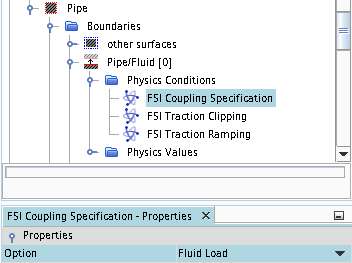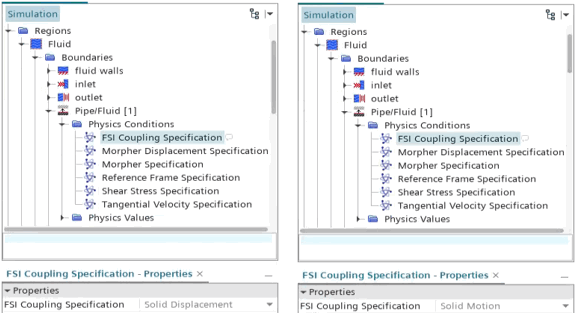FSI Solution Strategy
Simcenter STAR-CCM+ provides a concurrent solution strategy for solving FSI problems with a deformable solid.
- Exchange of Coupling Data
- Data Transfer
- Consistencies
- Solution Stabilization
For FSI problems with rigid 6-DOF bodies, see Deformable DFBI Bodies.
Exchange of Coupling Data
The concept of coupling data exchange in Simcenter STAR-CCM+ can be summarised in the table below:
| Motion Specification ↓ | Traction Specification | |
|---|---|---|
| Uncoupled | Fluid Load | |
| Rigid | Uncoupled | one-way fluid to solid |
| Solid Displacement | one-way solid to fluid | two-way |
| Rigid motions: All motions except Morphing and Solid Displacement | ||
The underlying concepts relating to the construction of this table are explained in the subsequent sections.
Fluid to Solid
- Data Transfer
- The information flowing from the fluid to the solid is the fluid traction. The fluid traction is automatically interpolated from the fluid side of the interface to the solid side where it is being applied as a load. In order to avoid the loss of information during the interpolation step you are advised to apply a similar mesh resolution on both sides of the interface. The interpolation scheme supports conformal and non-conformal interfaces.
- Consistency
- In general the force consistency is an important part of an FSI simulation. In certain cases the force consistency can be broken intentionally in order to reduce simulation time by omitting information transfer from the fluid to the solid. Moreover, Simcenter STAR-CCM+ allows you to improve the simulation stability by ramping or clipping the fluid traction.
Solid to Fluid
- Data Transfer
- The information flowing from the solid to the fluid is the interface deformation. The solid displacement is automatically interpolated from the solid side of the interface to the fluid side. In order to avoid losses during the interpolation step you are advised to apply a similar mesh resolution on both sides of the interface. The interpolation supports conformal and non-conformal interfaces.
- Consistency
- As mentioned above, in Simcenter STAR-CCM+ the interface deformation
is directly linked to the mesh motion. The following kinematic consistency
is enforced across the interface during solution initialization:
- Consistency of frames — meaning that both regions must use the same reference frame.
- Consistency of Interface Deformation — meaning that the mesh on both sides of the interface must deform in the same way.
Solution Stabilization
Simcenter STAR-CCM+ offers two different methods for solution stabilization — Dynamic and Constant Displacement Under-relaxation. Both methods are only available for transient cases.The purpose of the Dynamic is to increase the performance of the FSI simulation by predicting the fluid tractions resulting from the change of the interface position. It is assumed that a certain volume of fluid moves with the FSI boundary acting as an added mass. This method is recommended for two-way coupled problems.
- Automatic — Simcenter STAR-CCM+ estimates the volume of displaced fluid per unit area.
- Manual — you must specify the volume of displaced fluid per unit area, as described in Fluid-Structure Interaction General Workflow.
For Constant Displacement Under-relaxation you specify a fixed under-relaxation factor in the FSI solver which is then applied to the change of the interface displacement between consecutive iterations within a time step. The Under-relaxation factor is a single global value.

